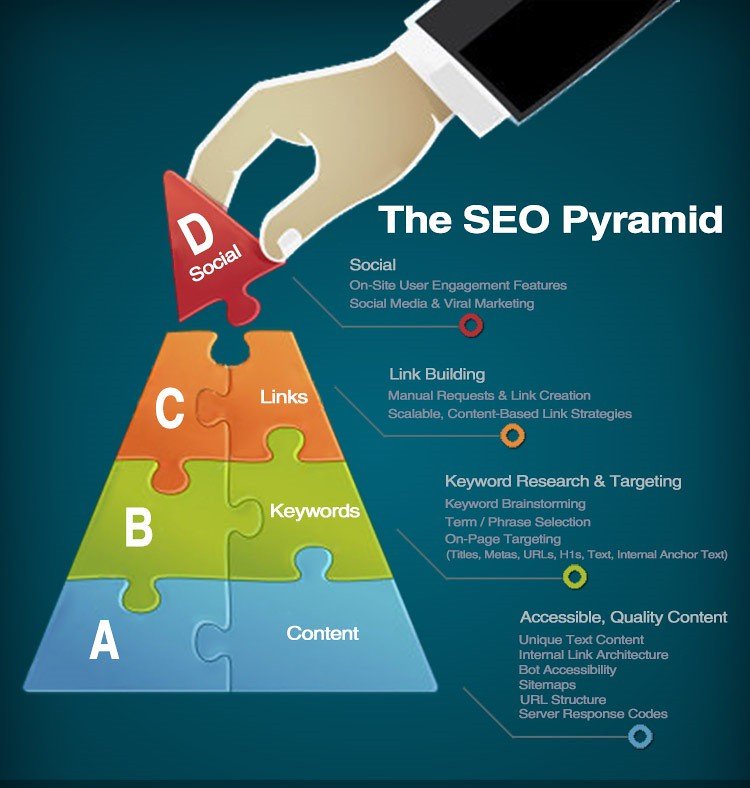In the realm of digital dominance, where search engine optimization (SEO) reigns supreme, a quiet but potent force has emerged as its unexpected ally – user experience (UX) design. While SEO has long been hailed as the gateway to online success, the significance of UX design in crafting exceptional website experiences should not be underestimated. These seemingly distinct disciplines are converging, intertwining their formidable powers to forge a new era of web design harmony. This article delves into the fascinating journey of the SEO & UX synergy, exploring the ways in which these forces unite to empower websites and revolutionize the digital landscape. Brace yourself for a captivating exploration of how design aligns with data and creativity fuses with strategy, all in pursuit of a singular goal – creating websites that leave a lasting impact on both search engines and the hearts of users.
Table of Contents
- 1. Unleashing the Potential: How Effective SEO Strategies Bolster User Experience
- 2. Crafting a Seamless Journey: Optimizing Website Design for Exceptional UX
- 3. Harmonizing User Intent and Technical SEO: Ensuring Relevance and Visibility
- 4. Embracing Mobile Optimization: Enhancing UX and SEO Performance
- Q&A
- The Conclusion

1. Unleashing the Potential: How Effective SEO Strategies Bolster User Experience
SEO and user experience (UX) go hand in hand when it comes to empowering websites and creating design harmony. Effective SEO strategies play a crucial role in bolstering user experience by ensuring that your website meets the needs and expectations of your target audience. Let’s dive into how these two elements work in synergy to unleash the potential of your website:
1. Enhanced visibility: SEO helps your website be more visible to search engines, making it easier for users to find you. By optimizing your website’s content, structure, and keywords, you can improve your search engine rankings and increase organic traffic. This increased visibility means more potential users can discover and benefit from your website’s offerings.
2. Improved user engagement: A well-optimized website not only attracts users but also keeps them engaged. User experience encompasses various aspects such as site speed, mobile-friendliness, and intuitive navigation. When your website is easy to navigate and loads quickly on any device, users are more likely to stay, explore, and interact with your content. This results in longer session durations, lower bounce rates, and ultimately, higher conversions.
3. Relevant and valuable content: SEO encourages you to create content that is not only search engine-friendly but also relevant and valuable to your target audience. By understanding search intent and incorporating relevant keywords, you can provide users with content that directly addresses their queries and needs. As a result, users are more likely to find the information they are looking for, trust your website as a reliable source, and potentially convert into customers.
4. Trust and credibility: Building trust and credibility is crucial in the online world. When your website ranks high in search engine results, users perceive it as a trustworthy and reliable source of information or products. SEO helps you build that trust by optimizing your website and ensuring it meets industry best practices. Additionally, by enhancing user experience, you create a positive impression and establish credibility, making users more likely to return to your website in the future.
In conclusion, the synergy between SEO and user experience empowers websites by driving organic traffic, improving engagement, and establishing trust. By implementing effective SEO strategies and focusing on optimizing user experience, you can unlock the full potential of your website, attracting and retaining users while meeting their needs and expectations.
2. Crafting a Seamless Journey: Optimizing Website Design for Exceptional UX
Designing a website that provides a seamless journey for users is not just about creating a visually appealing layout. It goes beyond aesthetics and delves into the realm of user experience (UX). When done right, an optimized website design can empower both SEO efforts and user engagement, creating a synergy that elevates the overall performance of a website.
One key aspect of crafting a seamless journey is ensuring a responsive and mobile-friendly design. With the majority of internet users accessing websites through their mobile devices, it is crucial to optimize your website for a variety of screen sizes. Responsive design allows your website to adapt and provide an optimal viewing experience, regardless of the device being used.
Another important element to consider is the layout and structure of your website. A well-organized and intuitive navigation system can make all the difference in ensuring a smooth user experience. Utilize clear and concise headings, subheadings, and navigation menus to guide users through your website effortlessly. Additionally, consider the placement of important elements such as call-to-action buttons and contact information to make them easily accessible and visible to visitors. By providing a intuitive and user-friendly design, you enhance the overall experience for your users and encourage them to engage with your website for longer durations.
3. Harmonizing User Intent and Technical SEO: Ensuring Relevance and Visibility
In today’s highly competitive digital landscape, achieving a harmonious balance between user intent and technical SEO is crucial for websites to thrive. When it comes to website design, the synergy between SEO and user experience (UX) plays a pivotal role in driving relevance and visibility. Let’s explore the key aspects of harmonizing user intent and technical SEO to empower websites through design harmony.
1. Content optimization: Crafting high-quality, relevant, and engaging content is the cornerstone of a successful website. By understanding user intent and conducting thorough keyword research, website owners can optimize their content to align with what their target audience is searching for. This involves strategically incorporating keywords throughout the content, including in headings, subheadings, and meta descriptions, to enhance visibility in search engine results pages (SERPs).
2. Intuitive navigation: Seamless navigation is a fundamental aspect of an optimal user experience. A well-designed website should have a clear and logical site structure, making it easy for visitors to find what they are looking for. Implementing intuitive navigation, such as a well-organized menu and internal linking, enhances user experience and helps search engines crawl and index the site effectively. By focusing on both user intent and technical SEO, websites can provide a positive user experience while improving their search engine rankings.
3. Mobile responsiveness: In today’s mobile-dominated world, having a mobile-responsive website is essential. Mobile compatibility not only caters to the growing number of mobile users but is also a crucial ranking factor for search engines. A responsive design ensures that the website automatically adjusts to fit any screen size, providing users with a seamless experience across devices. By prioritizing mobile responsiveness, websites can reach a wider audience and improve their visibility in search engine rankings.
4. Page speed optimization: User experience and page loading speed go hand in hand. Slow-loading websites often lead to high bounce rates and negatively affect search engine rankings. Optimizing page speed involves compressing images, minimizing code, and leveraging caching techniques to ensure fast and smooth website performance. By prioritizing page speed optimization, websites can keep visitors engaged, improve their search engine rankings, and provide a seamless browsing experience.
By harmonizing user intent and technical SEO, website owners can create a powerful synergy that empowers their websites through design harmony. With a user-focused approach and strategic optimization efforts, websites can not only enhance their visibility in search engine rankings but also engage and satisfy their target audience. Remember, the key is to strike a perfect balance between the technical aspects of SEO and the user experience to create a website that stands out in the digital realm.
4. Embracing Mobile Optimization: Enhancing UX and SEO Performance
The synergy between SEO and UX is a powerful force that can enhance websites and leave a lasting impact on users. Embracing mobile optimization is a crucial step in achieving this synergy, as it not only improves the overall user experience but also boosts SEO performance. Here are some ways in which mobile optimization can enhance both UX and SEO:
1. Responsive Design: Mobile optimization includes creating a website with responsive design, which ensures that the site adapts to different screen sizes and devices. This eliminates the need for users to constantly zoom or scroll horizontally, providing a seamless browsing experience. Moreover, search engines favor websites with responsive design, as they are more user-friendly and provide a consistent experience across devices.
2. Streamlined Navigation: Mobile optimization requires simplifying website navigation for smaller screens. This means prioritizing the most important content and organizing it in a user-friendly way. A mobile-friendly website employs tactics such as collapsible menus, hamburger icons, and sticky headers, making it easier for users to find what they’re looking for. This improved navigation not only enhances the user experience but also helps search engines crawl and index the website more effectively, boosting SEO performance.
With mobile devices becoming the primary means of accessing the internet, embracing mobile optimization is no longer an option but a necessity. By enhancing both SEO and UX, mobile optimization empowers websites to reach a wider audience, improve their ranking on search engine result pages, and ultimately drive more traffic and conversions. It’s a win-win situation, as users benefit from a seamless browsing experience, while website owners reap the rewards of increased visibility and engagement. Start optimizing your website for mobile today and unlock its full potential.
Q&A
Q: What is the SEO & UX Synergy all about?
A: The SEO & UX Synergy is the harmonious integration of search engine optimization (SEO) techniques and user experience (UX) design principles to empower websites by maximizing their visibility and delivering exceptional user experiences.
Q: How does the SEO & UX Synergy work?
A: This synergy works by optimizing websites to meet both search engine algorithms’ requirements and user expectations. By focusing on factors like mobile-friendliness, site speed, intuitive navigation, and relevant content, the SEO & UX Synergy ensures that websites rank well in search results and provide a seamless user journey.
Q: Why is SEO important for a website?
A: SEO plays a pivotal role in improving a website’s visibility and driving organic traffic. By strategically optimizing websites for targeted keywords, search engines can easily find, index, and rank them. It is an essential technique to enhance online presence and attract relevant users.
Q: What makes user experience (UX) so vital for websites?
A: UX is crucial because it focuses on providing users with a positive and gratifying experience when interacting with a website. It involves designing user-friendly interfaces, optimizing load times, providing valuable content, and ensuring effortless navigation. A good UX encourages users to stay longer, engage, and potentially convert into customers.
Q: How do SEO and UX work together?
A: SEO and UX work hand-in-hand to optimize a website’s performance both for search engines and users. SEO provides the technical foundation, optimizing various elements such as meta tags, URLs, and coding standards. UX, on the other hand, caters to the needs and desires of visitors, ensuring a delightful experience throughout their journey on the website.
Q: Can you give an example of how SEO & UX synergy can empower a website?
A: Certainly! Let’s say a website implements responsive design, making it accessible and user-friendly across all devices. This enhances the UX by providing a seamless browsing experience regardless of the screen size. Additionally, search engines reward mobile-friendly websites with higher rankings, boosting its overall SEO performance. This synergy empowers the website by attracting both search engines and users.
Q: How can businesses benefit from the SEO & UX Synergy?
A: Businesses can benefit immensely by leveraging the SEO & UX Synergy. Improved organic rankings through SEO attract more potential customers, while a seamless and user-centric experience enhances conversion rates. Furthermore, a strong online presence due to SEO boosts brand credibility and customer trust, ultimately leading to higher revenue and business growth.
Q: Are there any challenges in achieving SEO & UX harmony?
A: Yes, achieving SEO & UX harmony can be challenging. Balancing technical requirements for SEO with the creative aspects of UX design can sometimes lead to compromises. Efforts must be made to maintain a smooth balance between optimizing for search engines and meeting user expectations. Consistent coordination between SEO and UX specialists is vital to overcome these challenges and achieve a harmonious outcome.
Q: What are some best practices to achieve the SEO & UX Synergy?
A: To achieve the SEO & UX Synergy, it’s crucial to start by conducting thorough keyword research and understanding user intent. Then, designing intuitive navigation, creating high-quality and relevant content, optimizing site speed, and ensuring mobile-friendliness are key practices. Regular monitoring, analysis, and incorporating user feedback help to fine-tune the synergy further and maintain its effectiveness.
The Conclusion
In conclusion, embracing the powerful synergy between SEO and UX design is the key to unlocking the true potential of websites. By harmonizing these two elements, websites can truly empower themselves to rise above the competition and reach new heights of success.
Through a thoughtful blend of SEO strategies and user-centered design principles, websites can create a seamless and enchanting user experience that not only captivates visitors but also gains the approval of search engines. This dynamic partnership ensures that websites are not only aesthetically pleasing but also easily discoverable and highly functional.
The marriage of SEO and UX design empowers websites to tell compelling stories, engage customers, and drive meaningful interactions. With the right balance, websites can effortlessly guide users through their journey, leaving them satisfied and craving for more. The resulting increase in organic traffic, improved rankings, and enhanced conversions is a testament to the tremendous power of this collaboration.
Remember, the heart of any successful website lies in its ability to captivate both users and search engines. It is through the seamless fusion of SEO and UX design that websites can achieve this delicate harmony. By embracing this partnership, websites can evolve into living entities that connect, engage, and inspire users, while also staying ahead in the ever-evolving digital landscape.
So, let us not underestimate the power of design harmony, for it is through this fusion that websites transcend ordinary boundaries and become extraordinary experiences. By embracing the symbiotic relationship between SEO and UX, websites can empower themselves to reach the pinnacle of success and leave a lasting impact on their users.
In a world where online presence is paramount, the SEO and UX synergy is the ultimate catalyst that propels websites into the limelight. It is a harmonious dance between the technical and the creative, the analytical and the empathetic, the logical and the intuitive. Together, they empower websites to shine brightest, captivating audiences and unlocking endless opportunities.
So, let us embark on this journey of design harmony, embracing the powerful synergy between SEO and UX. For in this convergence lies the true empowerment of websites – a force to be reckoned with in the digital realm.

